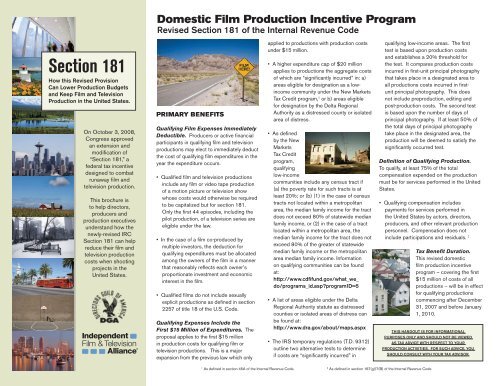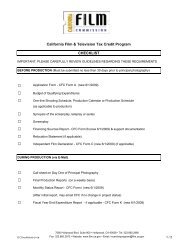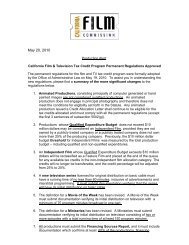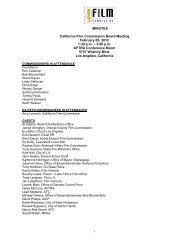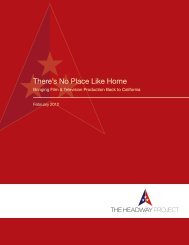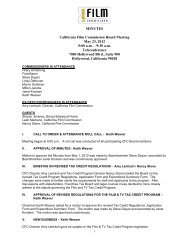Section 181 - California Film Commission
Section 181 - California Film Commission
Section 181 - California Film Commission
You also want an ePaper? Increase the reach of your titles
YUMPU automatically turns print PDFs into web optimized ePapers that Google loves.
<strong>Section</strong> <strong>181</strong><br />
How this Revised Provision<br />
Can Lower Production Budgets<br />
and Keep <strong>Film</strong> and Television<br />
Production in the United States.<br />
On October 3, 2008,<br />
Congress approved<br />
an extension and<br />
modification of<br />
“<strong>Section</strong> <strong>181</strong>,” a<br />
federal tax incentive<br />
designed to combat<br />
runaway film and<br />
television production.<br />
This brochure is<br />
to help directors,<br />
producers and<br />
production executives<br />
understand how the<br />
newly-revised IRC<br />
<strong>Section</strong> <strong>181</strong> can help<br />
reduce their film and<br />
television production<br />
costs when shooting<br />
projects in the<br />
United States.<br />
Domestic <strong>Film</strong> Production Incentive Program<br />
Revised <strong>Section</strong> <strong>181</strong> of the Internal Revenue Code<br />
PRIMARY BENEFITS<br />
Qualifying <strong>Film</strong> Expenses Immediately<br />
Deductible. Producers or active financial<br />
participants in qualifying film and television<br />
productions may elect to immediately deduct<br />
the cost of qualifying film expenditures in the<br />
year the expenditure occurs.<br />
• Qualified film and television productions<br />
include any film or video tape production<br />
of a motion picture or television show<br />
whose costs would otherwise be required<br />
to be capitalized but for section <strong>181</strong>.<br />
Only the first 44 episodes, including the<br />
pilot production, of a television series are<br />
eligible under the law.<br />
• In the case of a film co-produced by<br />
multiple investors, the deduction for<br />
qualifying expenditures must be allocated<br />
among the owners of the film in a manner<br />
that reasonably reflects each owner’s<br />
proportionate investment and economic<br />
interest in the film.<br />
• Qualified films do not include sexually<br />
explicit productions as defined in section<br />
2257 of title 18 of the U.S. Code.<br />
Qualifying Expenses Include the<br />
First $15 Million of Expenditures. The<br />
proposal applies to the first $15 million<br />
in production costs for qualifying film or<br />
television productions. This is a major<br />
expansion from the previous law which only<br />
1 As defined in section 45A of the Internal Revenue Code.<br />
applied to productions with production costs<br />
under $15 million.<br />
• A higher expenditure cap of $20 million<br />
applies to productions the aggregate costs<br />
of which are “significantly incurred” in: a)<br />
areas eligible for designation as a lowincome<br />
community under the New Markets<br />
Tax Credit program, 1 or b) areas eligible<br />
for designation by the Delta Regional<br />
Authority as a distressed county or isolated<br />
area of distress.<br />
• As defined<br />
by the New<br />
Markets<br />
Tax Credit<br />
program,<br />
qualifying<br />
low-income<br />
communities include any census tract if<br />
(a) the poverty rate for such tracts is at<br />
least 20%; or (b) (1) in the case of census<br />
tracts not located within a metropolitan<br />
area, the median family income for the tract<br />
does not exceed 80% of statewide median<br />
family income, or (2) in the case of a tract<br />
located within a metropolitan area, the<br />
median family income for the tract does not<br />
exceed 80% of the greater of statewide<br />
median family income or the metropolitan<br />
area median family income. Information<br />
on qualifying communities can be found<br />
at:<br />
http://www.cdfifund.gov/what_we_<br />
do/programs_id.asp?programID=5<br />
• A list of areas eligible under the Delta<br />
Regional Authority statute as distressed<br />
counties or isolated areas of distress can<br />
be found at:<br />
http://www.dra.gov/about/maps.aspx<br />
• The IRS temporary regulations (T.D. 9312)<br />
outline two alternative tests to determine<br />
if costs are “significantly incurred” in<br />
qualifying low-income areas. The first<br />
test is based upon production costs<br />
and establishes a 20% threshold for<br />
the test. It compares production costs<br />
incurred in first-unit principal photography<br />
that takes place in a designated area to<br />
all productions costs incurred in firstunit<br />
principal photography. This does<br />
not include preproduction, editing and<br />
post-production costs. The second test<br />
is based upon the number of days of<br />
principal photography. If at least 50% of<br />
the total days of principal photography<br />
take place in the designated area, the<br />
production will be deemed to satisfy the<br />
significantly occurred test.<br />
Definition of Qualifying Production.<br />
To qualify, at least 75% of the total<br />
compensation expended on the production<br />
must be for services performed in the United<br />
States.<br />
• Qualifying compensation includes<br />
payments for services performed in<br />
the United States by actors, directors,<br />
producers, and other relevant production<br />
personnel. Compensation does not<br />
include participations and residuals. 2<br />
2 As defined in section 167(g)(7(B) of the Internal Revenue Code<br />
Tax Benefit Duration.<br />
This revised domestic<br />
film production incentive<br />
program – covering the first<br />
$15 million of costs of all<br />
productions -- will be in effect<br />
for qualifying productions<br />
commencing after December<br />
31, 2007 and before January<br />
1, 2010.<br />
THIS HANDOUT IS FOR INFORMATIONAL<br />
PURPOSES ONLY AND SHOULD NOT BE VIEWED<br />
AS TAX ADVICE WITH RESPECT TO YOUR<br />
PRODUCTION ACTIVITIES. FOR SUCH ADVICE, YOU<br />
SHOULD CONSULT WITH YOUR TAX ADVISOR.
FREQUENTLY ASKED<br />
QUESTIONS<br />
Q: What<br />
are the key<br />
changes to<br />
<strong>Section</strong> <strong>181</strong> –<br />
The “Runaway<br />
Production”<br />
Federal tax<br />
incentive?<br />
A: <strong>Section</strong> <strong>181</strong>, which was first enacted by<br />
Congress in 2004, was extended and modified<br />
as part of the financial rescue package recently<br />
passed by Congress and enacted into law on<br />
October 3, 2008. It was extended for one year<br />
for qualified productions that begin the first day<br />
of principal photography before January 1, 2010.<br />
Importantly, it was also significantly modified so<br />
that the first $15 million ($20 million in the case<br />
of productions in certain low-income and eligible<br />
areas of the country) of film and television may<br />
be immediately written-off for tax purposes. This<br />
now makes the incentive available for film and<br />
television productions of all sizes, small or large.<br />
In addition, the new rules are retroactive for all<br />
productions commencing after December 31,<br />
2007.<br />
Q: When do productions need to commence to<br />
qualify for the new incentive?<br />
A: The incentive, which is ongoing since 2004,<br />
has now been broadened to include qualified<br />
productions commencing after December 31,<br />
2007, and before January 1, 2010.<br />
Q: Can the immediate write-offs be taken in<br />
more than one year?<br />
A: Yes, if an election is made to use the<br />
incentive, the immediate deduction takes place in<br />
the year the expenditure is incurred. Therefore,<br />
if production expenditures are incurred in more<br />
than one year, the immediate tax deduction will be<br />
taken in more than one year.<br />
Q: When, where, and how does the “election”<br />
to immediately deduct the qualifying expenditures<br />
apply?<br />
A: The election is to be made on the tax return<br />
for the taxable year in which the production costs<br />
are first incurred. The election must be made by<br />
the due date (including extensions of time) of such<br />
return.<br />
Q: What tax form do I need to fill out to get the<br />
incentive?<br />
A: Currently, there is no specific form to fill<br />
out. The IRS temporary regulations require<br />
that you declare in a separate statement that<br />
you are electing to utilize <strong>Section</strong> <strong>181</strong>. The<br />
legislative history also states that: “deducting<br />
qualifying costs on the appropriate tax return shall<br />
constitute a valid election.” Therefore, deducting<br />
the production costs (that would otherwise be<br />
capitalized) on your tax return will qualify as<br />
electing to take advantage of this incentive.<br />
Q: Does it apply to all productions (e.g., big<br />
budget productions)?<br />
A: Yes, as mentioned above, the immediate<br />
write-off provision now applies to the first $15<br />
million (or $20 million in low income or distressed<br />
areas) of costs for all productions regardless of<br />
the aggregate cost of the project.<br />
Q: What is the real benefit of this incentive?<br />
A: This is a significant Federal tax incentive<br />
that allows producers of qualifying productions<br />
to take an immediate tax deduction for the full<br />
or partial costs of a production in the year the<br />
cost is incurred (as opposed to having to spread<br />
or amortize those costs over a period of years<br />
beginning after the film goes to market).<br />
Q: How do I determine if it is beneficial to my<br />
production?<br />
A: Since the new incentive is elective,<br />
producers can run numbers with or without the<br />
new incentive and determine whether or not to<br />
elect to immediately expense the production costs<br />
in the first year(s).<br />
Q: Is the incentive transferable?<br />
A: No. However, depending on the investment<br />
structure you choose, multiple parties may be<br />
able to properly allocate costs that could be<br />
immediately expensed.<br />
Q: What happens in the case of a co-<br />
production or a film financed by multiple<br />
investors?<br />
A: The $15 million ($20 million) threshold refers<br />
to the qualifying film. The benefits of the provision<br />
must be allocated among the owners of a film in<br />
a manner that reasonably reflects each owner’s<br />
proportionate investment in and economic interest<br />
in the film.<br />
Q: In order to qualify for the higher ($20<br />
million) deduction, what does it mean to require<br />
that a “significant” amount of the expenditures be<br />
incurred in an eligible area?<br />
A: The IRS temporary regulations outlined two<br />
alternative tests to determine if the “significantly<br />
occurred” requirement is met. One test is<br />
based upon production costs and establishes<br />
a 20% threshold for the test. It compares<br />
production costs incurred in first-unit principal<br />
photography that takes place in a designated<br />
area to all productions costs incurred in first-unit<br />
principal photography. This does not include<br />
preproduction, editing and post-production costs.<br />
The second test is based upon the number of<br />
days of principal photography. If at least 50% of<br />
the total days of principal photography take place<br />
in the designated area, the production will be<br />
deemed to satisfy the significantly occurred test.<br />
Q: How will other practical issues related to<br />
this broadened incentive be determined?<br />
A: Like other tax issues, producers should<br />
consult with their professional tax advisors on any<br />
issues related to this new Federal tax incentive.<br />
In light of the new legislation, the Treasury and<br />
IRS may revise their temporary regulations, which<br />
may come in the form of Notices and Regulations.<br />
A number of groups that worked on this important<br />
legislative change are expected to continue<br />
working with the Treasury Department and the<br />
IRS to ensure the incentive fulfills its objective and<br />
provides the industry with meaningful tax relief.<br />
Q: Are there other Federal tax incentives that<br />
may be valuable to film productions?<br />
A: Yes, all US based productions continue to<br />
have other potential incentives including a 6%<br />
tax deduction from gross revenues for U.S. film<br />
and television production activities (<strong>Section</strong> 199).<br />
Producers should consult with their professional<br />
tax advisors for other tax incentives that may be<br />
available.<br />
The DGA and IFTA have worked with a<br />
coalition of film industry organizations<br />
for nearly ten years to stem the tide of<br />
runaway production. The current effort<br />
focused on amending <strong>Section</strong> <strong>181</strong> to<br />
make the United States a competitive<br />
place for film and television production.<br />
Combined with the incentives that many<br />
states have enacted, DGA and IFTA<br />
believe that the federal incentive will<br />
serve as an effective tool to keep more<br />
television and film production in the<br />
United States.<br />
Runaway Production Alliance Members:<br />
Academy of Television Arts and Sciences<br />
American Federation of Musicians<br />
American Federation of Television and Radio Artists<br />
Association of Independent Commercial Producers<br />
Association of Talent Agents<br />
The Caucus for Television Producers, Writers<br />
and Directors<br />
Directors Guild of America<br />
<strong>Film</strong> Musicians Secondary Markets Fund<br />
Hollywood Post Alliance<br />
International Alliance of Theatrical Stage Employees<br />
Producers Guild of America<br />
Independent <strong>Film</strong> & Television Alliance<br />
International Brotherhood of Teamsters, Local 399<br />
Recording Musicians Association<br />
Screen Actors Guild<br />
US <strong>Film</strong> <strong>Commission</strong> Caucus, Association of<br />
<strong>Film</strong> <strong>Commission</strong>ers International<br />
FOR MORE INFORMATION PLEASE<br />
CONTACT YOUR TAX ADVISOR


